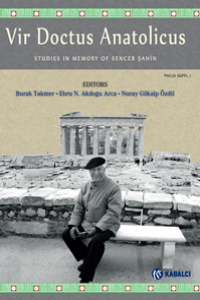Araştırma Makalesi
Yıl 2016,
Cilt: Suppl. 1, 234 - 237, 31.08.2016
Öz
Bu makalede Isparta Müzesi’nden beş adet mezar yazıtı tanıtılmaktadır.
Eserlerin hepsi Roma Dönemi’ne aittir. Buluntu yerleri belli olmayan ilk üç
stel antik Conane çevresinde bulunan mezar taşlarıyla stilistik açıdan büyük
benzerlik göstermektedir. Bu taşlar muhtemelen Gönen İlçesi’nden müzeye
getirilmiştir. Diğer iki taş Roma Dönemi’ne ait torso biçimli mezar taşlarıdır.
Taşların tabanında görülen ve Pisidia Bölgesine özgü isimler, bölge halkının
özellikle Roma Döneminde torso türünde mezar taşlarını yaygın olarak kullanmış
olduklarını göstermektedir.
Anahtar Kelimeler
Kaynakça
- Haspels 1971 C. H. Emilie Haspels, The Highlands of Phrygia. Sites and Monuments, 2 vols, Princeton 1971.
- Iversen 2012 P. A. Iversen, Inscriptions from Pisidian Konane and the Surrounding Area, Epigraphica Anatolica 45, 2012, 103–152.
- Sterrett 1888a J. R. S. Sterrett, An Epigraphical Journey in Asia Minor (during the summer of 1884), Papers of The American School of Classical Studies at Athens, 2, 1883/1884, Boston 1888.
- Sterrett 1888b J. R. S. Sterrett, The Wolfe Expedition to Asia Minor (during the summer of 1885), Papers of The American School of Classical Studies at Athens, 3, 1884/1885, Boston 1888.
Yıl 2016,
Cilt: Suppl. 1, 234 - 237, 31.08.2016
Öz
In this article five gravestones from Isparta Archaeology Museum are
presented. All stones belong to the Roman Imperial Period. The first three gravestones,
in the shape of stelae, whose provenance are unknown, are similar to the
gravestones stylistically found around the ancient city of Conane. These stones
were probably brought to the museum from the county of Gönen. The other two
stones, in the shape of a torso, probably brought to the museum from the
ancient city of Seleuceia Sidera, belong to the Roman Period as well. The names
which are seen on the base of these stones endemic to the region of Pisidia,
show that the inhabitants of this region commonly used these kind of stones, in
the shape of a torso, especially in the Roman Period.
presented. All stones belong to the Roman Imperial Period. The first three gravestones,
in the shape of stelae, whose provenance are unknown, are similar to the
gravestones stylistically found around the ancient city of Conane. These stones
were probably brought to the museum from the county of Gönen. The other two
stones, in the shape of a torso, probably brought to the museum from the
ancient city of Seleuceia Sidera, belong to the Roman Period as well. The names
which are seen on the base of these stones endemic to the region of Pisidia,
show that the inhabitants of this region commonly used these kind of stones, in
the shape of a torso, especially in the Roman Period.
Anahtar Kelimeler
Kaynakça
- Haspels 1971 C. H. Emilie Haspels, The Highlands of Phrygia. Sites and Monuments, 2 vols, Princeton 1971.
- Iversen 2012 P. A. Iversen, Inscriptions from Pisidian Konane and the Surrounding Area, Epigraphica Anatolica 45, 2012, 103–152.
- Sterrett 1888a J. R. S. Sterrett, An Epigraphical Journey in Asia Minor (during the summer of 1884), Papers of The American School of Classical Studies at Athens, 2, 1883/1884, Boston 1888.
- Sterrett 1888b J. R. S. Sterrett, The Wolfe Expedition to Asia Minor (during the summer of 1885), Papers of The American School of Classical Studies at Athens, 3, 1884/1885, Boston 1888.
Toplam 4 adet kaynakça vardır.
Ayrıntılar
| Birincil Dil | Türkçe |
|---|---|
| Konular | Dilbilim |
| Bölüm | Makaleler |
| Yazarlar | |
| Yayımlanma Tarihi | 31 Ağustos 2016 |
| Yayımlandığı Sayı | Yıl 2016 Cilt: Suppl. 1 |


